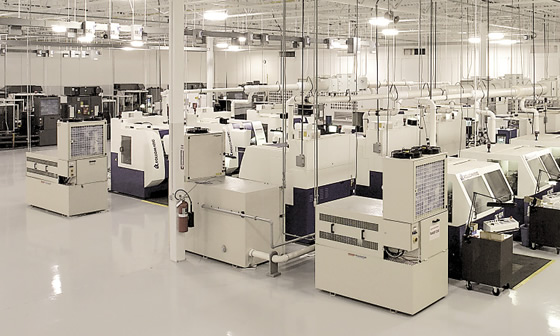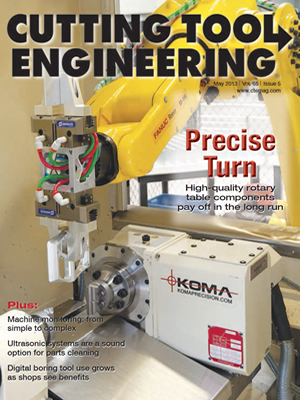END USER: Garr Tool Co., (989) 463-6171, www.garrtool.com.
CHALLENGE: Consistently produce complex cutting tools, even when unattended machining.
SOLUTION: A cellular grinding oil filtration system.
SOLUTION PROVIDER: Transor Filter USA, (800) 354-3040, www.transorfilter.com.
More than 70 years ago, Garr Tool Co. discovered that the formula for manufacturing high-quality carbide cutting tools to exacting customer specifications requires a combination of advanced grinding machine technology and well-trained machinists. In that time, the company has expanded from a modest storefront facility to a 180,000-sq.-ft.-plus manufacturing plant in Alma, Mich.
Garr Tool is organized into three departments, each consisting of a specific OEM machine technology: Rollomatic, Walter and ANCA. “We tend to run certain groups of tools in each of the departments so we can specialize more,” said Garr Tool Production Supervisor Scott Conner. “The Walter department usually runs tools from 0.5 " to 1.25 " in diameter. The Rollomatic department does smaller tools, from about 0.0020 " to 0.5 " in diameter, and our ANCA grinders handle a lot of resharpening and small-lot tools.”
The majority of Garr’s tool and cutter grinders incorporate varying forms of automation for handling workpieces and changing wheels. This enables the toolmaker to run lights-out production between the two regularly scheduled shifts, a contributor to Garr’s growth over the last decade.
Conner pointed out that a major development in Garr’s overall manufacturing operation was the introduction of OMF units from Transor Filter USA, Elk Grove Village, Ill. The OMF system removes fines as small as 1µm from grinding oil.
Garr had been utilizing several different methods of filtration, including settling tanks, centrifuge systems and cartridge-style filters. After seeing the OMF system at a trade show and then discussing its performance with some users, Garr was convinced that the system would enhance its equipment’s performance.

Each of Garr Tool’s Transor Cellular Centralized systems, such as the ones in the foreground, filters the grinding oil from two or three tool and cutter grinders.
“I was a bit skeptical at first,” Conner said, “but after that first Transor was installed, I was amazed at the cleanliness of the oil. I never would have imagined that filtration could play such a significant role in our manufacturing operation.” After that initial trial and realizing the difference the OMF system made compared to the cartridge filters it was using, Garr began replacing the filters and now uses the Transor equipment exclusively.
In addition, the OMF system enhances lights-out machining, helping Garr meet customer deadlines. “With temperature-controlled oil filtered consistently to 1 micron,” Connor said, “we have confidence the grinding technology will consistently produce high-quality tools during unattended production.”
To best match its physical plant and continued growth strategies, Garr installed the Transor Cellular Centralized system, where a single Transor unit services two or three grinders. With the work cell arrangement, Garr’s 47 filtration units supply each of the company’s more than 120 tool and cutter grinders with clean oil maintained to a ±0.01° C temperature.
He added that with Transor’s easy-to-handle disposal bags, Garr’s carbide reclamation program has accelerated because the carbide residue in the sludge does not contain any foreign filter media or other material. This enables Garr to receive top dollar for the reclaimed carbide.
With customers’ requirements for more specialized applications, Garr has increasingly been producing more complex tooling, such as multiple-flute tools with variable helixes and indexes to minimize harmonic vibration. With the filtration units, there is virtually no carbide particle build up, or loading, of the grinding wheels, Conner noted. This enables Garr to hold the tight tolerances, often 0.0002 ", these tools demand and with greater consistency and repeatability. Conner pointed out that without wheel loading, the company spends less time redressing the wheels, resulting in greater machine uptime and faster cycle times.
Cleanliness is a major objective in Garr’s manufacturing operation. Because the Transor filtration system has self-cleaning filter elements, Conner noted maintenance issues continue to be minimized, virtually eliminating replacement of wear items such as spindles, bearings and ways because carbide particulate doesn’t collect in the bottom of the machines and around the moving parts. It is apparent to everyone, including visitors, how clean the machines are.
“Because the carbide particulate is so small, fine and abrasive, filtering was not easy prior to the Transors,” Conner said. “And because the elements are cleaned automatically, we don’t have to replace filter cartridges, and I haven’t missed that at all.”
In his 30-plus years at Garr, Conner said he has learned that to achieve maximum efficiency it is important to “look at the whole picture. The process should include good machines, in-depth training of your machine operators, high-quality wheels and oil, temperature control and proper filtration.”
Related Glossary Terms
- abrasive
abrasive
Substance used for grinding, honing, lapping, superfinishing and polishing. Examples include garnet, emery, corundum, silicon carbide, cubic boron nitride and diamond in various grit sizes.
- centrifuge
centrifuge
Filtering device that uses a spinning bowl and the differences in specific gravities of materials to separate one from another. A centrifuge can be used to separate loosely emulsified and free oils from water-diluted metalworking fluid mixes and to remove metalworking fluids from chips.
- grinding
grinding
Machining operation in which material is removed from the workpiece by a powered abrasive wheel, stone, belt, paste, sheet, compound, slurry, etc. Takes various forms: surface grinding (creates flat and/or squared surfaces); cylindrical grinding (for external cylindrical and tapered shapes, fillets, undercuts, etc.); centerless grinding; chamfering; thread and form grinding; tool and cutter grinding; offhand grinding; lapping and polishing (grinding with extremely fine grits to create ultrasmooth surfaces); honing; and disc grinding.
- grinding machine
grinding machine
Powers a grinding wheel or other abrasive tool for the purpose of removing metal and finishing workpieces to close tolerances. Provides smooth, square, parallel and accurate workpiece surfaces. When ultrasmooth surfaces and finishes on the order of microns are required, lapping and honing machines (precision grinders that run abrasives with extremely fine, uniform grits) are used. In its “finishing” role, the grinder is perhaps the most widely used machine tool. Various styles are available: bench and pedestal grinders for sharpening lathe bits and drills; surface grinders for producing square, parallel, smooth and accurate parts; cylindrical and centerless grinders; center-hole grinders; form grinders; facemill and endmill grinders; gear-cutting grinders; jig grinders; abrasive belt (backstand, swing-frame, belt-roll) grinders; tool and cutter grinders for sharpening and resharpening cutting tools; carbide grinders; hand-held die grinders; and abrasive cutoff saws.
- micron
micron
Measure of length that is equal to one-millionth of a meter.


